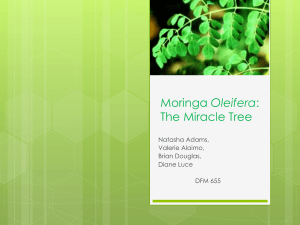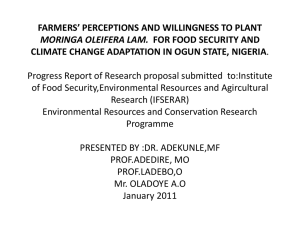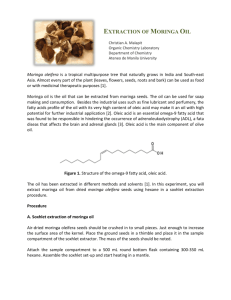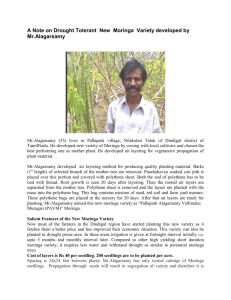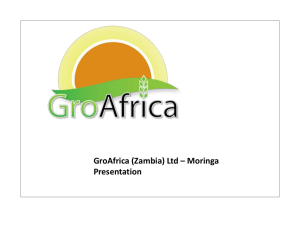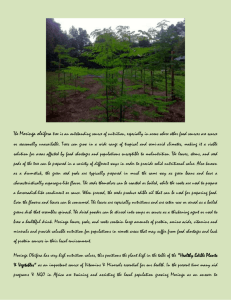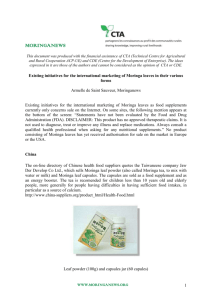MORINGA MANUAL - PCTanzania.org
advertisement
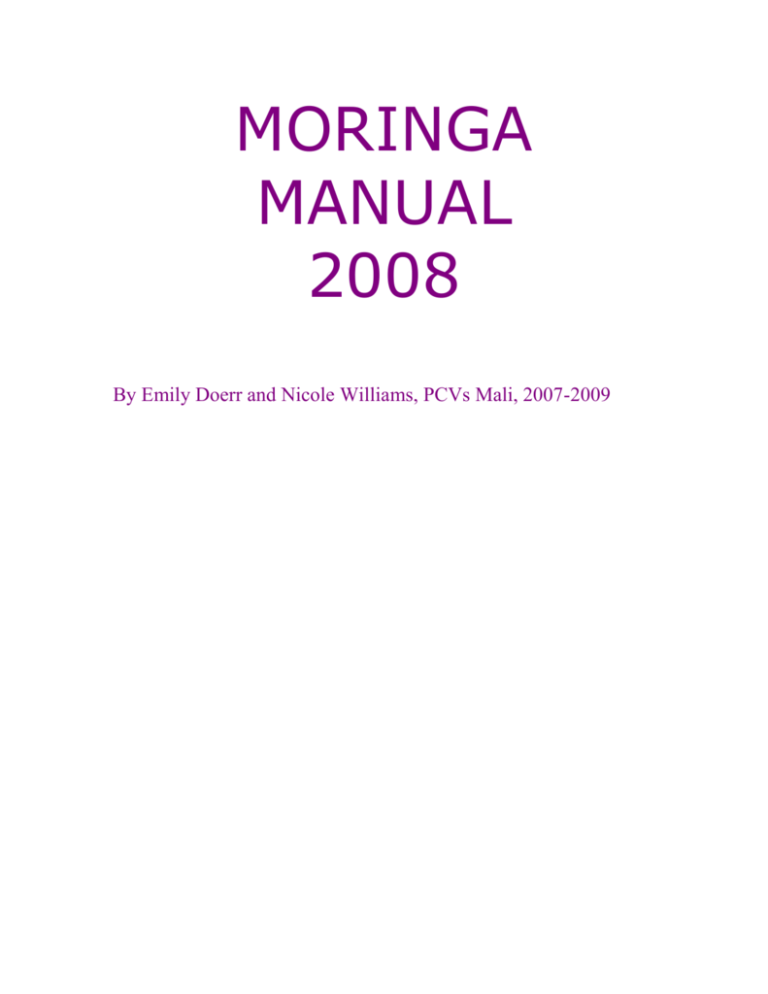
MORINGA MANUAL 2008 By Emily Doerr and Nicole Williams, PCVs Mali, 2007-2009 CONTENTS Page 2. History of Moringa Description Nutritional Information Page 3. Nutritional Information Contd. Page 4. The Three Food Groups of Mali Page 5. Uses of Moringa Page 6. Natural Medicine Other Uses Page 7. Water Purifying Page 8. Cultivation of Moringa Growing from Cutting Page 9. Caring for Moringa Page 10. Vitamin and Mineral Guide Page 13. Physical Signs of Nutritional Deficiency Page 14. How to Make Moringa Soap Page 15. How to Do a Moringa Animation Appendix Page 17. Nutritional Breakdown of Moringa Page 18. Suggested Daily Intake Children Ages 1-3 Page 19. Suggested Daily Intake Lactating Women Page 20. Poster Examples for Formations Page 21. Miscelaneous Pictures Page 24. Cultivation of Moringa Page 29. Water Purification History of Moringa Highly valued by the ancient Roman, Greek and Egyptian civilizations, the Moringa tree is now being “rediscovered” in many areas of the globe. A native plant of the Western Himalayas and India, Moringa is now widely grown throughout the tropics. There are 14 varieties of Moringa that come from several different regions. The variety we grow in Mali is the Moringa Oleifera and is also known as the Ben-oil tree, Cabbage tree, Horseradish tree, Drumstick tree, Mother’s Best Friend and Miracle tree. The Moringa plant is native to Northern India, where it was first described around 2000 B.C. as a medicinal herb. The oral tradition of Ayurvedic medicine in India declared that Moringa prevents 300 diseases. Ancient Egyptians treasured Moringa oil as protection for their skin from the ravages of desert weather. Later, the Greeks found many healthful uses for Moringa and introduced it to the Romans. Over the centuries, the Moringa plant has been carried to all the tropical parts of the world, where it readily takes root. It is commonly used for food, for medicinal purposes, as a wind-break in fields, and many other purposes. The Moringa plant spread eastward form India to the lower parts of China, Southeast Asia and the Philippines. From India it also spread westward to Egypt, the Horn of Africa, around the Mediterranean, and finally to the West Indies in America. On the island of Jamaica in 1817, a petition concerning Moringa oil was presented to the Jamaican House of Assembly. It described the oil as being useful for salads and culinary purposes, and being equal to the best Florence oil as an illuminator--giving clear light without smoke. The leaves and pods were likewise used in local recipes. In America, Moringa can be found in markets which cater to immigrants from India, Sri Lanka, China and the Philippines. Usually this is in the form of frozen or canned foodstuffs. Description Moringa Oleifera is a deciduous tree that grows up to 12 meters tall with an umbrellashaped crown. Moringa is extraordinarily vigorous and grows very well in dry climates (or in climates with long periods of dryness and short periods of rain) and in areas with poor soil quality. The trees can be propagated from seedlings, seeds, or cuttings. It grows extremely fast and regularly reaches up to four meters in its first year. A mature tree flowers once a year and in some places twice a year. Leaves: Leaves alternate, bi or tri-pinnate, 20-70 cm long. Leaflets are usually oval, rounded at the tip and 1-2 cm long. They are dark green in color and almost whitish on the lower surface. Flowers: Cream colored and yellow in long sprays, each flower holds five petals, one erect and four bent back. The flower is sweet smelling and attractive to insects, especially bees. Seed Pods: Long capsules that are 45 cm long and triangular in shape. When dry they split open to reveal dark brown, 3-winged seeds. Wood: The wood is very soft and not very useful for carpentry or charcoal making but can be used as firewood or for making blue dye. Nutritional Information An individual needs sufficient amounts of certain vitamins, minerals, protein and other nutrients to maintain a healthy body and physical well-being. The Moringa tree is an excellent source for many of these nutrients and can be a valuable source for many people of the African sub-region. Just 100 grams of fresh leaves will provide a child ages 1-3 with all his daily requirements for calcium, about 75% of his iron and about half of his protein needs, as well as important supplies of potassium, B vitamins, copper and all the essential amino acids. For a pregnant or breast-feeding woman, 10 grams of fresh leaves can supply over a third of her daily calcium requirements as well as provide necessary quantities of iron, protein, copper, sulfur and B vitamins. Nutrient Vitamin A Vitamin C Calcium Potassium Protein Moringa Leaves 6780 mcg 220 mg 440 mg 259 mg 6.7 gm Other Foods Carrots: 1890 mcg Oranges: 30 mg Cow's milk: 120 mg Bananas: 88 mg Cow's milk: 3.2 gm Protein: Proteins are the “building blocks of life” and instrumental in the creation and maintenance of body muscle. There are 21 amino acids utilized by the body and although the body is able to manufacture most that it needs, there are several amino acids that must be acquired from a person’s diet. These “essential” amino acids are listed in the chart above (argentine, histidine, lysine, tryptophan, phenylanaline, methionine, thereonine, leucine, isoleucine, valine). Usually, only animal products such as meat, eggs, and dairy contain all of the essential amino acids. Amazingly, Moringa leaves also contain them all. Carbohydrates: Compounds heat and energy for the body and the primary fuel of the brain. Deficiency can cause the body to divert proteins and body fat to produce needed energy. Fat: Fat is the most concentrated form of energy for the body and while excessive amounts can be damaging, some body fat is essential for insulation under the skin and protection of vital organs. It is also an important supply of energy for the body during times of famine. Fiber: Fiber aids in digestion and is an important part of a healthy intestinal tract. Calcium (Ca): Very important during the childhood years, calcium builds strong bones and teeth and assists in blood clotting. Deficiencies are common in pregnant and breastfeeding women and can cause rickets, bone pain and muscle weakness. Calcium builds strong bones and teeth, and helps prevent osteoporosis. Milk provides a lot of calcium, but Moringa leaves provide even more. 4 times the Calcium of Milk. Magnesium (Mg): Magnesium helps the body to maintain and repair cells while providing energy. Deficiencies can result in weakness, tiredness, vertigo, convulsions, nervousness, cramps and heart palpitations. Vitamin A: Vitamin A acts as a shield against diseases of the eyes, skin and heart, diarrhea, and many other ailments. Carrots are very high in vitamin A, but Moringa leaves are even higher. 4 times the vitamin A of carrots. Vitamin C: Vitamin C strengthens our immune system and fights infectious diseases including colds and flu. Citrus fruits such as oranges and lemons are full of vitamin C. Moringa leaves have even more. 7 times the Vitamin C of oranges. Potassium: Potassium is essential for the brain and nerves. Bananas are the excellent source of potassium. Moringa leaves are even better. 3 times the Potassium of Bananas. NORTH CENTR (Gao, Mopti, Timbuctou) KAYES (Kayesville, Mahina, Diamou, Yelimane, SIKA AL Baflabe, Manantali) (Segou, Bamako, Koulikoro) O (Bougoun Kadiola, S All Seasons rice, meat, fish, butter, dates, millet millet, peanuts, beans, fish, meat millet, fish, beans, peanuts, meat Rainy Season Dry Season green leaves, earth peas green leaves green leaves beets, salad, onion, carrots, tomatoes, watermelon mangos, hibiscus, gumbo, tomatoes, watermelon green onions, squash NOTE: In the regional capitals most foods are available year around - whereas, in small villages food is often limited regardless of the season and the region. In the Appendix is a breakdown of the nutritional content of the leaves, pods and flowers of the Moringa tree, all of which are edible. Values are given for 100 gram servings. The percentage of the recommended daily intake (according to the WHO) for children ages 1-3 and lactating women is also shown. Following the chart is a brief description of the role each nutrient plays in the healthy development of a child and body of lactating women. Although not mentioned, men may reap equal benefits from consumption of any Moringa tree foods. The Three Food Groups in Mali Foods contain chemical substances known as nutrients. These can be divided into three categories according to their function: energy nutrients, construction nutrients, and protection nutrients. Commonly eaten foods can be broadly divided into three groups according to these three functions. Most foods contain a mixture of the three categories of nutrients, but usually one of the categories is present in larger amounts than the other two, and the function of that nutrient becomes the function of that food. For example, foods such as rice and wheat have all three categories of nutrients, but the energy nutrients are the most abundant and therefore providing energy is the main function of cereals. However, if a cereal is consumed in large amounts, it also supplies enough nutrients to promote growth. Remember that men and women living in different environments remain healthy on many different food combinations. And, common foods in one country may not be considered food in another country. In developing countries, there is a common, monotonous pattern among adult diets. The main portion of the diet consists of cereals because they are the cheapest foods available. Supplementary foods include beans, peas, peanuts, green leafy vegetables that are often eaten with the cereal to provide additional nutrients, variety, and a more palatable meal. Protective foods are incorporated in corn, mille yam, fonio potatoes, s potatoes, o peanuts green leav bananas, g eggs, corn mangos, p salad, tom carrots, wa sauces, and as snacks and deserts. Foods of animal origin are expensive and usually consumed on special occasions. With improvement in economic status, the quantity of fats and oils in the diet increases. In the context of Moringa, supplementing proteins and vitamins are the most important things you can do. The taste is strong so it is best to mix the Moringa leaves or powder into sauces, however, Moringa acts as an energy, construction and protection food. When teaching about the nutritional value of Moringa it is good to use the food groups as a tool. Some Malians have been exposed to the food groups through other health campaigns; adding to what they already know is a productive way of teaching. Energy Foods: Cereals (rice, wheat, corn, millet, ‘to’) Fats and oils Starchy vegetables (potatoes, sweet potatoes, cassava) Sugar, molasses, honey Construction Foods: Foods of animal origin (milk, eggs, fish, meat) Some foods of vegetable origin (pulses, peas, beans, nuts) Protection Foods: Vegetables (green leafy) Yellow, orange and red colored fruits and vegetables (carrots, papayas, mangoes, tomatoes, oranges, watermelon) Sour fruits (oranges, limes, lemons, grapefruit) Uses of Moringa All of the parts of the tree can be used in a variety of ways. Moringa is full of nutrients and vitamins and is good in your food as well as in the food of your animals. Moringa helps to clean dirty water and is a useful source of medicines. It provides lots of leafy material that is useful when using alley-cropping systems. Human food All Moringa food products have a very high nutritional value. You can eat the leaves, especially young shoots, young pods, flowers, roots, and in some species even the bark. Leaves are low in fats and carbohydrates and rich in minerals, iron and vitamin B. It is particularly useful as a human food because the leaves appear towards the end of the dry season when few other sources of green leafy vegetables are available. Fresh leaves: Of all the products of the tree the leaves are used the most. They become tougher as they get older so it is best to pick the growing tips and young leaves. Remove the leaves from the woody stem, as this will not soften during cooking. The leaves can be used in the same way as spinach. An easy way of cooking them is to steam 2 cups of freshly picked leaves for a few minutes in one cup of water, seasoned with an onion, butter and salt or other seasonings according to taste. Dried leaves: A leaf powder can be produced by drying the leaves and crushing or pounding them. You can sift the powder to remove leaf stems. This powder can then be added to sauces at the same time as other condiments or vegetables are added. Flowers: The flowers can be cooked and mixed with other foods or fried in batter. They can also be placed in hot water for five minutes to make a kind of tea. They are also a good source of nectar for honey producing bees. Pods: The pods can be eaten from when they first appear to when they become too woody to snap easily (up to 30cm long). They are cooked like other green beans and have a similar flavor to asparagus. Beware as some bitter varieties are poisonous if too many are eaten. Even the pods that have become too woody can be boiled until they are tender. They are opened and the white flesh is scraped out and returned to the boiling water. This can be used in soups and stews. Seeds: The seeds are often referred to as peas and can be used from the time they appear until they turn yellow and their shells begin to harden. Experience will help decide when the best time to harvest the pods for their peas. To cook, remove from the pod with their soft winged shells intact and as much white flesh that can be scraped out from the pod. Put the peas and flesh into a strainer and wash them to remove the sticky, bitter film that covers them, or boil them for a few minutes then drain and boil again in fresh water. They can then be used as any other green pea. When the seeds are mature, their coating hardens and becomes bitter. This can be pressed for oil extraction. If a press is not available the seeds can be browned or roasted, ground, added to boiling water and the oil floats to the surface. The seeds contain 35% oil and this is used for cooking purposes. The oil does not turn rancid and also burns without smoke. Roots: A sauce similar to horseradish sauce can be made from the roots when the seedling is only 60cm tall. The root bark should be completely removed as it contains harmful substances, then the root is ground up and vinegar and salt are added. However, it should not be eaten in excess. It is best to store the sauce in a refrigerator. Gum: The gum that is found in the bark can be used to season food. Animal fodder: Cattle, sheep, pigs, goats and poultry browse the bark, leaves and young shoots of Moringa. The best diet for pigs is 70% Moringa, 10% Leucaena and 20% other leaves. It is possible for their diet to be 100% Moringa but it should be no more than 30% Leucaena. The pork from pigs fed on this diet is lean. If trees are intended for animal fodder it is useful to prune them to 4m high, but if they are not they should be pruned to 6m so harvesting for human consumption can be easily carried out. Livestock diets are improved by the addition of Moringa products. Natural Medicines Around the world every part of the Moringa tree has been used effectively against varying ailments. Some of the remedies are described here but there is no guarantee they will work for every case! Leaves: Leaves rubbed against the temple can relieve headaches. To stop bleeding from a shallow cut, apply a poultice of fresh leaves. There is an anti-bacterial and anti-inflammatory effect when applied to wounds or insect bites. Extracts can be used against bacterial or fungal skin complaints. Leaf tea treats gastric ulcers and diarrhea. Eating Moringa food products is good for those suffering from malnutrition due to the high protein and fiber content. Flowers: Flower juice improves the quality and flow of mothers’ milk when breast feeding. Flower juice is useful for urinary problems as it encourages urination. Pods: If eaten raw, pods act as a de-wormer and treat liver and spleen problems and pains of the joints. Due to high protein and fiber content they can play a useful part in treating malnutrition and diarrhea. Seeds: Used for their antibiotic and anti-inflammatory properties to treat arthritis, rheumatism, gout, cramp, sexually transmitted diseases and boils. The seeds are roasted, pounded, mixed with coconut oil and applied to the problem area. Seed oil can be used for the same ailments. Roasted seeds and oil can encourage urination. They can also be used as a relaxant for epilepsy. Roots, bark & gum: The roots and the bark have all of the properties described above but are more concentrated. Therefore much more care should be taken if using them as medicines. Other Uses Fertilizer: The seed cake, which is produced by pressing the seeds to extract oil, cannot be eaten as it contains harmful substances. However, it contains high levels of protein and makes a good fertilizer for use in agriculture. Live Fencing: Planted as a living fence, Moringa provides wind protection and shade. It grows very quickly and if cuttings are planted close together they will form a fence that livestock cannot get through in just 3 months. Alley cropping: Moringa has a large tap root and few lateral roots so it will not compete for nutrients with the crops. It will also add to the nutrients available as it produces many protein rich leaves. They grow very quickly but do not provide too much shade due to the structure of their leaves. They are also very good at reclaiming marginal land. Natural pesticide: By digging Moringa leaves into the soil before planting, damping off disease (Pythium debaryanum) can be prevented among seedlings. Cleaning agent: Crushed leaves are used to clean cooking utensils or even walls. Fuel wood: The wood is light and is a good fuel for cooking. However, it is not suitable for building. The bark can be beaten into a fiber that can be used to make rope or mats and the wood produces a blue dye. Chippings of wood can be used to make a good quality paper. The tree also produces viscose resin that is used in the textile industry. Honey Clarifier: Clarified seeds can be used to clarify honey without boiling. Seed powder can also be used to clarify sugar cane juice. Honey Producer: Flowers are good source of nectar for honey producing bees. Oil: The seeds of the Moringa tree are 28% oil by weight. This oil is slightly sweet, turns rancid slowly and is used for cooking, making soap, as a lubricant for machinery and extraction of essential oils in perfume. It is slightly yellow and odorless. Pulp: The soft, spongy wood produces a wood pulp for making newsprint and writing paper. Tanning Leather: The bark and gum can be used in tanning hides. Biogas: Moringa leaves provide an excellent material for production of biogas. Water Purifying Seed powder can be used as a quick and simple method for cleaning dirty river water. The powder joins with the solids in the water and sinks to the bottom. This treatment also removes 90-99% of bacteria contained in water. Using Moringa to purify water replaces chemicals such as aluminum sulphate, which are dangerous to people and the environment, and are expensive. Twenty liters of water can be treated in the following way: 1. Remove the wings and brown seed coat and discard any seed kernels that have dark spots or any other signs of damage. 2. Pound the kernels to a fine powder. 3. Add 2 grams (2 small spoons) of powder to one cup of clean water, pour into a bottle and shake for 5 minutes. 4. Filter the solution through a clean cloth into the bucket of dirty water that is to be treated. 5. Stir the water quickly for 2 minutes and slowly for 10 to 15 minutes (do not use metal implements). 6. Leave the bucket undisturbed for one hour or until the water becomes clear and the impurities have sunk to the bottom. 7. Filter the water through a clean cloth. 8. Boil the water before drinking. Water from varying sources will need different amounts of powder because of the impurities present will not be the same. Experiments with a jar will help in working out the correct amount needed. Both the seeds and the seed powder can be stored but the solution made in stage 3 should not be stored. It should be freshly made every time water is to be purified. Honey and sugar cane juice can also be cleared of impurities using the powder. Moringa stenopetala seeds have better water purifying properties than Moringa oleifera. Cultivation of Moringa The Moringa tree tolerates a wide range of soil and rainfall conditions, making it ideal and easy to cultivate for its various uses. Minimum annual rainfall requirements are estimated at 250 mm with a maximum of over 3,000 mm. The presence of a long taproot makes it resistant to periods of drought. Its temperature range is 25-35 degrees C, but the tree will tolerate up to 48° C in the shade and can survive a light frost. Although a freeze can kill a tree to the ground, it will afterwards send out new shoots. Moringa will flower once a year and in some places twice beginning about eight months after planting. During its first year, it can grow up to four meters, and if left alone, will reach 12 meters in height with a trunk 30 cm in diameter. To maintain a bushier appearance, the tree can be cut back annually to one meter or less from the ground and will quickly recover to produce pods and flowers within reach. Within 3 years of planting one tree will produce 300 to 400 pods every year and a mature tree can produce up to 1000 pods. Frequent pruning of the growth tips will maintain and increase leaf growth and the height can be controlled to make harvesting easier. Growing from Seed: Seeds have no dormancy periods and can be transplanted as soon as they are mature but should only be kept for up to 3 months in natural conditions. Before sowing, soak the seeds in water overnight. Planted in sacks, trees can be transplanted after 4-6 months. The soil mixture for the sacks should be light (1 part sand to 1 part compost). Plant 2 seeds in each sack 2 inches deep. Keep moist but not too wet and germination should occur within 2 weeks. Remove weaker seedlings, leaving one in each sack. (The germination period for Moringa Is short so if you only plant one seed per sack and it doesn’t grow you’ll know right away and can plant another, it is not necessary to always plant 2 seeds per sack.) Seedlings can be planted when they are 60-90 cm high but they are very fragile. Depending on the type of soil you have, you’ll want to prepare the ground for planting. If you have a hard soil, you should dig a hole no shallower than 30 cm deep and 30 cm in diameter. Fill the hole with 1 part sand and 1 part compost (this is the ideal situation, however, Moringa are very strong trees and could easily grow in unfertilized soil, as long as the ground is soft) and then place the tree in the hole so the height of the ground is the same as the top of the soil in the bag. You do not necessarily need to remove the entire bag from the tree. Because the sand breaks apart so easily it might be easier to just cut off the plastic on the bottom and plant the rest of the plastic with the tree. The roots will grow straight down which has not shown to affect the general growth of the tree. If the ground is relatively soft already there should be no need to till the ground too much before planting. It always helps to add a good amount of compost to the area to ensure fast growth. It is most effective to plant seedlings in the late afternoon to avoid exposure to the sun immediately after planting. Do not water heavily after planting. Growing From Cuttings Planting from cuttings will result in the fastest growth, but whether or not the resulting trees are superior to those planted from seed is undetermined. Some sources claim that trees from cuttings will produce superior, however others have observed that trees from cuttings produce inferior fruit and have a shallower root development which makes the tree more susceptible to drought. For cuttings use hard wood as opposed to green. Cuttings can be 45 cm to 1.5 cm long and 4-16 cm wide. They can be planted directly or in sacks in a nursery, although when placed in a nursery, the root system is slower to develop. Cuttings should be left to dry in a shady, dry place for three days before planting. When planting directly, place cuttings in light, sandy soil. Plant one-third of the length in the ground and add nitrogen to poor or degraded soils to encourage root development. Do not over water, if the soil is too heavy or wet, the roots may rot. Cuttings placed in nursery can be out planted after 2 or 3 months. Caring For Moringa Watering: Moringa trees do not need much watering. In very arid conditions, water regularly for the first 5 months and not at all after that unless the tree is visibly suffering. Trimming: If left alone, the Moringa tree has a tendency to grow straight and tall, putting out leaves and pods only at its crown. To encourage the production of many branches and pods within easy reach of the ground, cut off the central growing tip when the tree is 1.5 or 2 m high. Regularly cut off the tips of the branches to encourage the tree to become bushier (these growing tips can be eaten). Another method is to cut each branch back 30 cm when it reaches 60 cm in length, producing a multi-branched Moringa shrub. If the tree is being grown for pod production, removing the flowers in the first year will increase the pod yield the second year. Older trees, which are unproductive or too high for easy harvesting, can be cut off to ground level. In India, unproductive trees are cut down to stump from which one or two shoots are allowed to grow and used as cuttings for the plantation of new trees. In Mali, we teach people to prune them so they will get bushy and stay short. After the tree is about two meters tall you can start pruning it. Cut the top off at about 1 or 1.5 meters and then trim the branches 10 centimeters from the end. Use the cuttings to put in sauce or dry them and make Moringa powder for later use. Eventually new branches will grow from where you cut them and you’ll be able to prune them again in 4-6 weeks. Spacing: Spacing in planting will depend on the type of soil and end-use of trees. Recommended spacing is anywhere from three to five meters while for intensive production of green matter, Moringa can be densely seeded (100 seeds per sq meter) and the edible shoots cut like grass every two to three weeks. Trees are often spaced one meter apart in a line to create live fencing posts. Trees can be planted in gardens and the light shade given by the Moringa trees will help those vegetables which are less tolerant to direct sunlight. Trees are often used to support climbing crops such as yams and pole beans, however, Moringa is said to be highly competitive with eggplant and sweet corn (reducing yields up to 50%). At Tubani So, we have planted a Moringa food bank with spacing no less than 10 cm. Along a 10 meter area we planted around 100 seeds. This spacing is ideal for food banks and easier to maintain because the trees are in closer proximity. As they get bushier it may be useful to thin the area and keep the trees with the higher yields of leaves. Fertilizing: Moringa trees will generally grow well without fertilizer. In some parts of India however, ring trenches are dug about 10 cm from trees during the rainy season and filled with green leaves, manure and ash, then covered. This practice is said to promote higher yields of pods. Research done in India has shown that applications of 7.5 kg farmyard manure and 0.37 kg ammonium sulfate per tree can increase pod yields threefold. In Mali, compost materials are easy to find and easy to teach to Malians (chances are they already know how to make it), which means that you should use fertilizer because it will definitely increase your yields, help your trees grow faster and develop healthier trees that will last better through the drier months. Harvesting: Leaves- For making leaf sauces, use seedlings, growing tips or very young leaves. Older leaves must be stripped from the tough and wiry stems. These are more suited for making dried leaf powder, since the stems can be removed during the sifting process. Pods- Moringa trees will flower and produce pods whenever water is available and will have a continuous yield if rainfall is constant throughout the year. In arid conditions, flowering an be induced through irrigation. In some cases, it may be necessary to prop up a branch, which holds many pods to prevent it breaking off. When harvesting pods for human consumption, gather the pods when they are still young and pliable for eating whole. Older pods develop a tough exterior, but their pulp and immature seeds remain edible until shortly before the ripening process begins. When producing seed for oil extraction, allow the pods to dry and turn brown on the tree. Harvest them before the pods split open and fall to the ground. Seeds can be stored in wellventilated sacks in dry, shady places. Pests and Diseases: Moringa is resistant to most pests, however in very water-logged conditions, seedlings can be planted in mounds so that excess water is drained off. Termites can be a problem in some areas and various caterpillars will eat the leaves. Cattle, sheep, pigs and goats will eat Moringa seedlings, pods and leaves so caution must be taken to protect seedlings from livestock by installing fencing or by planting hedge around the plantation. For mature trees, the lower branches can be cut so that goats will not be able to reach the leaves and pods. Vitamin and Mineral Guide Regulatory Nutrients (vitamins & minerals) – not an energy source; function primarily in the regulation of body processes; indirectly involved in supplying energy and in growth and maintenance. Vitamins – ‘accessory growth factors’; essential organic compounds required in very small amounts (micronutrients) that are involved in fundamental functions of the body such as growth, development, maintenance of health and as a regulator of metabolism. Minerals – elements in the body that are inorganic and not consumed by either thermal or chemical oxidation; an essential mineral is one that is required for life, growth and reproduction when other nutrients are sufficient. Factors that Affect Vitamin and Mineral Requirements and Status Age (infants have higher needs due to growth) Gender (women need more iron and calcium) Food Choices (vegetarian) Climate (hotter climates require less Vitamin D due to sun exposure) Level of Physical Activity (increased activity requires additional micronutrients) Drugs (some drugs affect vitamin and mineral absorption) Clinical Conditions (cancer & HIV/AIDS patients require additional micronutrients) VITAMIN C (ASCORBIC ACID) RDA – adults 45-75mg/day; smokers 100mg/day FOOD SOURCES (Specific to Mali) – oranges, lemons, limes, green peppers, tomatoes, potatoes, cabbage, strawberries, NIDO, avocadoes, grapefruit, mangos FUNCTIONS IN THE BODY – anti-oxidant, collagen synthesis, wound healing, fatty acid synthesis, neurotransmitter synthesis SIGNS OF DEFICIENCY – scurvy (swollen inflamed gums, fatigue, weakness, loose teeth, loss of hair, shortness of breath, muscle cramps, aching bones, joints, and muscles, loss of appetite, anemia), poor wound healing, bone fractures SIGNS OF TOXICITY – megadoses (kidney stones, diarrhea, increased iron absorption) VITAMIN B1 (THIAMIN) DRI – female 1.1mg/day; males 1.2mg/day FOOD SOURCES (Specific to Mali) – yeast, grains, nuts, pork, NIDO, dark green leafy vegetables, okra, millet, corn, eggs, beans, liver, fish FUNCTIONS IN THE BODY – helps maintain tissue and energy production-storage, essential for growth and pregnancy, important for membrane and nerve conduction SIGNS OF DEFICIENCY – Beriberi (peripheral neuropathy, confusion, edema, cardiac disturbances), Wenicke-Korsakoff Syndrome (observed in alcoholics) – ataxia, mental confusion, dementia, double vision, irreversible damage SIGNS OF TOXICITY – rare VITAMIN A (b-Carotene is the plant source of Vitamin A and our bodies convert it to an active form of Vitamin A) RDA – females 800mg RE/day; males 1000mg RE/day; pregnant 800mg RE/day; lactating 1200-1300mg RE/day; (conversion factor – 1 RE = 0.3 IU) FOOD SOURCES (Specific to Mali) – Vitamin A (liver, NIDO); b-Carotene (mangoes, melons, carrots, bananas, raw cabbage, raw lettuce, cooked peas) FUNCTION IN THE BODY – anti-oxidant (helps prevent cellular destruction or injury), vision, cellular differentiation (required for epithelial cells to maintain normal structure and function), growth, fertility/reproduction, immunity, skin health SIGNS OF DEFICIENCY – common in developing counties in children under 5 years of age; night blindness, corneal ulcers, xerophthalmia, keratinization, ¯ appetite, risk of infection, dry/rough/scaly skin, growth failure, malabsorption, death SIGNS OF TOXICITY – megadoses 15,000mg RE/day (nausea, vomiting, headache, diffuse redness over skin, brittle nails, gum inflammation, fatigue, hair loss, double vision, eczema, bone fractures, liver damage, death) VITAMIN E (TOCOPHEROL) RDA – females 8mg a TE/day; males 10mg a TE/day; (conversion factor – 1mg aTE = 1.49 IU) FOOD SOURCES (Specific to Mali) – seed/vegetable oils, margarine, soybeans, wheat germ, nuts (peanuts), NIDO FUNCTIONS IN THE BODY – anti-oxidant (helps protect cellular functions, retards aging) SIGNS OF DEFICIENCY – red blood cell fragility and hemolysis (hemolytic anemia) VITAMIN B2 (RIBOFLAVIN) DRI – females 1.1mg/day; males 1.3mg/day FOOD SOURCES (Specific to Mali) – milk, NIDO, bread, liver, eggs, meat, legumes, plantains, oranges, termites, mangos FUNCTIONS IN THE BODY – essential for carbohydrate, protein and fatty acid metabolism, growth/energy factor SIGNS OF DEFICIENCY – cheilosis/angular stomatis (lip lesions and cracks at the corners of mouth), glossitis (inflammation of the tongue), excema/dermatitis SIGNS OF TOXICITY – rare VITAMIN B3 (NIACIN) DRI – females 14mg NE/day; males 16mg NE/day; (conversion factor – 1 NE = 1 mg niacin or 60 mg dietary tryptophan) FOOD SOURCES (Specific to Mali) – meat, grains, milk, NIDO, coffee, tea, eggs, wheat flour, peanuts, poultry, beans, peas FUNCTIONS IN THE BODY – energy metabolism, high doses of nicotinic acid decrease serum lipid levels SIGNS OF DEFICIENCY – Pellagra (red skin, abdominal pain/anorexia, delirium, anxiety, depression, death), weakness SIGNS OF TOXICITY – flushing, liver damage, increased uric acid levels, dermatological problems, increased blood glucose levels COPPER ESADDI – adults 1.5-3mg/day FOOD SOURCES (Specific to Mali) – liver, peanuts, legumes FUNCTIONS IN THE BODY – iron metabolism, collagen synthesis, formation of neurotransmitters, aids iron absorption, enzyme function SIGNS OF DEFICIENCY – depigmentation, defective collagen and elastin, nervous disorders, depressed immune system, skeletal demineralization, Menke’s Kinky Hair Syndrome (genetic disease), anemia SIGNS OF TOXICITY – megadoses (vomiting, nausea, liver damage, gastric hemorrhage), Wilson’s Disease (genetic disorder) MAGNESIUM RDA – females 310-320mg/day; males 400-420mg/day FOOD SOURCES (Specific to Mali) – green leafy vegetables, nuts, legumes, unmilled grains FUNCTIONS IN THE BODY – carbohydrate metabolism, fatty acid degradation, protein synthesis, DNA synthesis, bone/tooth formation, muscle contraction, nerve transmission SIGNS OF DEFICIENCY – observed with alcoholism and severe malnutrition, anorexia, weakness, low blood pressure, coma SIGNS OF TOXICITY – megadoses (diarrhea, decreased blood pressure, depression of respiration, coma, paralysis, heart failure) IRON RDA – females 15mg Fe/day; males 10mg Fe/day; pregnancy 30mg Fe/day FOOD SOURCES (Specific to Mali) – liver, NIDO, red meat, green leafy vegetables, dried fruits, eggs, poultry FUNCTIONS IN THE BODY – transport oxygen and carbon dioxide, energy metabolism, drug metabolism, red blood cell production, immune function SIGNS OF DEFICIENCY – hypochromic microcytic anemia, impaired cognitive tasks, impaired immune system, weak, pale, cracked lips, irritable SIGNS OF TOXICITY – tissue damage CALCIUM RDA – children 1300mg/day; females 1300mg/day; males 1000mg/day; elderly 1200mg/day FOOD SOURCES (Specific to Mali) – milk and dairy products, NIDO, green leafy vegetables, peppers, potatoes, dried fish, beans, baobab fruit FUNCTIONS IN THE BODY – bone/tooth formation, blood clotting, muscle/heart contraction, nerve conduction, enzyme regulation, cell membrane permeability SIGNS OF DEFICIENCY – rickets (poor bone formation in children), osteomalacia (softening of bone in adults), osteoporosis (decrease in bone mass in adults), muscle contractions, spasms and pain SIGNS OF TOXICITY – vomiting, kidney stones, constipation, soft tissue calcification Physical Signs of Nutritional Deficiency Site Sign Possible Deficiency Skin Dry & Scaling Petechiae, Ecchymosis Follicular Hyperkeratosis Pellagrous dermatosis “Flaky Paint” dermatosis Hair Dull, dry, thin, & pluckable Vitamin A Vitamin C, Vitamin K Vitamin A, Vitamin C, Essential Fatty Acid Niacin, Tryptophan Protein Protein, Essential Fatty Acid Eyes Eyelid lining & whites pale Bitot’s spots Corners of eyes cracked w/ red or inflamed eyelids Cornea dull, milky, hazy, or opaque Magenta tongue, taste buds atrophied Glossitis Bleeding gums Cheilosis Angular stomatitis Anemia Vitamin A Riboflavin, Niacin Vitamin A Edema Muscle wasting Decreased sub-cutaneous fat Disorientation Protein Protein-Calorie Malnutrition Thiamin, Niacin Mouth General Appearance Neurologic Riboflavin Niacin, Folate, Vitamin B12 Vitamin C Riboflavin, Niacin, Iron, Pyridoxine Riboflavin, Niacin, Iron, Pyridoxine, Vitamin B12 How to Make Moringa Soap Materials/Equipment: Mortar/pestle Drinking cup 2 drinking cups Moringa seed powder (about 1-2 plastic bags full of seeds) 2 tbls. Soda ½-1 drinking cup water basin long stick/wooden spoon gloves Tami Fragrance or coloring Plastic bag to put made soap on to dry Preparation: 1. Gather as many moringa seeds as possible- you will need a lot! 2. Pound and tami – leaving outer shell on moringa seed, this will act as an exfoliate 3. 4. 5. 6. 7. 8. 9. 10. Being careful not to breathe in soda fumes and wearing gloves, mix 2 cups moringa powder with 2 spoons of soda When well mixed after about 5 minutes, you will see the soda start to dissolve as it reacts with the oil in the moringa. Add water ½ cup at a time- be sure to stir constantly Add fragrance or coloring if desired When finished, mixture should not be too thin or thick- ideally the consistency of peanut butter Form balls while wearing gloves or mold in lightly oiled sardine can Put formed soap on plastic bag and let it sit for two weeks After two days it should become firm and dry, but two weeks is needed for the soda to cure so that it can be safely used as body soap. How to Do a Moringa Animation By Nicole Williams Moringa tree has extraordinary nutritional and health benefits which can be easily assimilated into Malian culture. The promotion of the tree can also be included in many sectors. Choose the topic to focus on in correlation with your audience. For example, an animation with women in villages should start with health and nutrition information as it is most pertinent to them and would not need to go into statistical detail in contrast to an animation with an organization whose members are all highly educated greater care needs to be taken to provide statistical information. An animation with the men of the village would probably concentrate on the agricultural side of the tree with emphasis on using it as live fencing, intercropping, and as an animal feed. Beginning the animation with the most important information for your audience will grab and hold their attention at the start. The more animated you are the more likely you are to keep attention focused on the animation. The more hands-on examples the better the animation will be. All of the materials involved in this animation are optional, but the more you have available the more likely you will be to hold your audience’s attention. When talking about the seeds and their taste pass around some seeds and ask the participants if they want to eat one. Start a Moringa tree nursery three months before the formation and give the participants a sapling or have a handful of seeds available for each participant. Partner with a health volunteer and combine the Moringa animation with an animation on ameliorated porridge using Moringa powder. It is important to stress the fact that Moringa needs to be dried in the shade, and should be repeated multiple times during the animation. Also, to ensure that your audience understands the information presented, ask questions or ask the participants to summarize what was just said frequently throughout the presentation. An example animation for women in village that has been performed: Explain what you are doing and the purpose of the animation: Today we are going to talk about Moringa and its attributes, because it has many nutritional and health benefits. Bi, An bena kuma basiyirini kan. A nafa ka bon. A nafa ka ca. A be se ka keneya deme ni den bonya. Vitamini caman b’a bolo. A ka di mogo bee, nka a ka di ko jugu denna ni muso konoma ani muso be sin di den ma. Health: The Moringa tree has many health benefits. Each part of the tree helps many different ailments. (At this point use the moringa manual to list the parts of the tree and the illnesses they assist). Basiyiri be keneya deme. Yiri bulu ni yiri faara ni yiri kise ni yiri nyeji…yiri bee be se ka keneya deme. Nutrition: The Moringa tree has many vitamins that can help ameliorate malnutrition, and is especially good for children, pregnant women, and nursing mothers. During pregnancy and when nursing, women use a lot of their vitamin intake to support their child. The consumption of Moringa powder introduces large quantities of vitamins which are difficult to find in traditional meals. Consuming Moringa can help a child gain weight and provides many of the essential vitamins for proper growth. In one day a child should consume three teaspoons full of moringa powder and a pregnant woman or nursing mother should consume six teaspoons full. This will provide more vitamin C then seven oranges, more calcium than four glasses of milk, more vitamin A than carrots, more protein than milk, and more potassium than bananas. (An brief explanation of each vitamin is helpful and the food groups they correlate to in Mali…i.e. protein is found in meat and makes people stronger and is in the construction food group). Vitamini caman be basiyiri bolo. A ka di fo denw, muso konoma, ani muso min be sin di den ma. Waatimin musu be konoma walima muso be sin di den ma den be muso ka vitamini caman dune. Muso ka kan ka vitamini were soro dumuni kono. Basiyiri be vitamini caman di muso ma ni a be bla na kono. Basiyiri be se ka den bonya. Tile kelen kono den be basiyiri bulu mugu kotunye saaba dun ni muso konoma ani muso be sin di den ma be basiyiri bulu mugu kotunye woro dun. Ni mogo be nin dun a bena vitamini C ka ca ni lenburuba wolonfila soro ni calciumi ka ca ni nono veri naani soro, ni vitamini A ka ca ni carroti soro, ni proteini ka ca ni nono soro, ani potassium ka ca ni banan soro. To Eat: The leaves can be eaten fresh or dried and made into a powder. When fresh they can be eaten like lettuce and have a slightly spicy flavor. The leaves can be dried in the shade (the sun will kill the vitamins) and pounded into a powder. The powder can then be added to sauces and porridge after they have been removed from the fire. The seed pods can be eaten when they are green raw or warmed in a sauce. The seeds can be eaten like peanuts, but they have a very astringent taste. The flowers can be boiled to make tea. (Let the women taste the powder and seeds). I be se ka bulu kene dun inafo salati ani a ka farin dooni. Walima I be se ka bulu ja sumala ka mugu bwo ka bla na la. Nka ni bulu be ja tilela vitamini bena tinye. I ka kan ka bulu ja sumala sabu tile be vitamini faga. Basiyiri mugu be se ka ke nala walima serila, nka I ka kan ka na walima seri bwo tasumala folo ka bla duguma sabu tasuma be se ka vitamini faga. Basiyiriden be dun waatimin a ye binkenema ye. A be dun kene walima nala. Basiyiri kise be dun tiga tan, nka a man di dooni. Feri be wuli the tan. To Filter Water: (Start this at the very beginning of the formation. Have one of the women shake the bottle while you do introductions). A Moringa seed pounded into a powder has the ability to filter one liter of water (if the water is very dirty two seeds should be used). First mix the Moringa seed powder with the water for ten minutes and then let it sit for one hour. The seed powder will bind to dirt and bacteria in the water and will settle to the bottom of the bottle. When the water is clear it can be filtered through a clean cloth and drunk. Mogo be se ka ji sensen ni basiyiri kise mugu ye. Ji literi kelen kise kelen, nka ni ji nogolendon kosabe Ji literi kelen kise fila. Folo I be basiyiri kise mugu ke jila ka nyagami. I bena lamaga lamaga fo miniti tan oka a bena to fo eri kelen. Kise mugu bena cencen ani banakise soro ka mine ka bla duguma. Eri kelen kofe waatimin ji jemendon a be tenten finila ka min. To Plant: To plant a Moringa tree starting with seeds. Soak the seeds overnight. The bad seeds will float on the top of the water and the good seeds will sink to the bottom. The soaking will start the process of germination and must be planted on the following day. When soaked the seeds should sprout within three days and if not soaked it can take seven or more. Moringa gets tall very quickly and the leaves can be harvested multiple times in the first year. Do not water the tree too much because too much water can kill the tree. Ka Basiyiri kise dan I ka kan ka kise bla jila ka men su kelen. Ni kise a man ni a bena to ji kan. Nin kise be fili. Ni kise a ka ni a bena bla duguma. N’I man kise bla ji la a bena falen ka suma fo tile wolonfila. Ni a be bla ji la a bena falen tile saaba kono. Basiyiri bena janya ka teli ni mogo be se ka bulu soro sanni san kelen be bwo. Kanna basiyiri son kosabe. Ji be basiyiri faga. To Harvest Seeds: When the Moringa tree is at shoulder height the leaves can be harvested to eat raw or make into powder. Every month the leaves can be harvested and made into powder. Waatimin yiri ka janya n’I kamankun ye kelen ye, kuna tige. Kalo o kalo I bena bulu tige. Appendix Nutritional Breakdown of Moringa Pods, Leaves and Powder Moisture (%) Calories Protein (g) Carbohydrates (g) Fat (g) Fiber (g) Minerals (g) Calcium (mg) Magnesium (mg) Potassium (mg) K (mg) Cu (mg) Fe (mg) S (mg) Oxalic Acid (mg) Vitamin A (mg) Vitamin B (mg) Vitamin B1 (mg) Vitamin B2 (mg) Vitamin B3 (mg) Vitamin C (mg) Vitamin E (mg) Arginine (g/16 g Nitrogen) Histidine (g/16 g Nitrogen) Lysine (g/16 g Nitrogen) Tryptophan (g/16 g Nitrogen) Phenylanaline (g/16 g Nitrogen) Methionine (g/16 g Nitrogen) Pods 86.9 26 2.5 3.7 0.1 4.8 2 30 24 110 259 3.1 5.3 137 10 0.1 423 0.05 0.07 0.2 120 Leaves 75 92 6.7 13.4 1.7 0.9 2.3 440 24 70 259 1.1 7 137 101 6.8 423 0.21 0.05 0.8 220 3.6 1.1 1.5 0.8 4.3 1.4 6 2.1 4.3 1.9 6.4 2 Leaf Powder 7.5 205 27.1 38.2 2.3 19.2 2,003 368 204 1,324 0.6 28.2 870 0 16.3 2.6 20.5 8.2 17.3 113 0 0 0 0 0 0 Thereonine (g/16 g Nitrogen) Leucine (g/16g Nitrogen) Isoleucine (g/16 g Nitrogen) Valine (g/16 g Nitrogen) 3.9 6.5 4.4 5.4 Suggested Daily Intake for Children Ages 1-3 Suggested Daily Intake for Lactating Women 0 0 0 0 Children Ages 1-3 Pods (100g) Moisture (%) Calories Protein (g) Carbohydrates (g) Fat (g) Fiber (g) Minerals (g) Calcium (mg) Magnesium (mg) Potassium (mg) K (mg) Cu (mg) Fe (mg) S (mg) Oxalic Acid (mg) Vitamin A (mg) Vitamin B (mg) Vitamin B1 (mg) Vitamin B2 (mg) Vitamin B3 (mg) Vitamin C (mg) Vitamin E (mg) Arginine (g/16 g Nitrogen) Histidine (g/16 g Nitrogen) Lysine (g/16 g Nitrogen) Tryptophan (g/16 g Nitrogen) Phenylanaline (g/16 g Nitrogen) Methionine (g/16 g Nitrogen) Thereonine (g/16 g Nitrogen) Leucine (g/16g Nitrogen) Isoleucine (g/16 g Nitrogen) Valine (g/16 g Nitrogen) 4.9 9.3 6.3 7.1 Leaves (100g) Leaf Powder 7.50% 16.00% 13.80% 32.40% 388% 53.90% 110% 16.00% 8.70% 32.40% 138% 70% 40% 20.60% 2.00% 13.20% 5.70% 22.60% 0.06% 453% 86% 10.00% 8.80% 2.20% 600% 42.00% 6.30% 8.90% 1100% 6.90% Lactating Women Moisture (%) Calories Protein (g) Carbohydrates (g) Fat (g) Fiber (g) Minerals (g) Calcium (mg) Magnesium (mg) Potassium (mg) K (mg) Cu (mg) Fe (mg) S (mg) Oxalic Acid (mg) Vitamin A (mg) Vitamin B (mg) Vitamin B1 (mg) Vitamin B2 (mg) Vitamin B3 (mg) Vitamin C (mg) Vitamin E (mg) Arginine (g/16 g Nitrogen) Histidine (g/16 g Nitrogen) Lysine (g/16 g Nitrogen) Tryptophan (g/16 g Nitrogen) Phenylanaline (g/16 g Nitrogen) Methionine (g/16 g Nitrogen) Thereonine (g/16 g Nitrogen) Leucine (g/16g Nitrogen) Isoleucine (g/16 g Nitrogen) Valine (g/16 g Nitrogen) Pods Leaves Leaf Powder 2.50% 9.20% 9.20% 8.60% 155% 35.30% 36.70% 5.80% 5.80% 8.60% 55% 46.70% 13.40% 1.40% 1.40% 3.50% 2.30% 0.01% 119% 22.80% 3.10% 3.90% 1.00% 126% 13.10% 2.80% 4.00% 231% 1.50%
